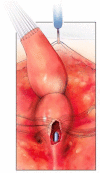Cloacal Malformations: Technical Aspects of the Reconstruction and Factors Which Predict Surgical Complexity
- PMID: 31259166
- PMCID: PMC6587123
- DOI: 10.3389/fped.2019.00240
Cloacal Malformations: Technical Aspects of the Reconstruction and Factors Which Predict Surgical Complexity
Abstract
Cloacal malformations are rare anomalies which occur in one in 50,000 live births. Anatomically these anomalies are defined by the presence of a single perineal orifice. There is however a substantial range in their complexity. Defining these differences is key to surgical planning and timely referral of selected cases to centers with the capabilities to manage the most challenging cases. Traditionally the common channel length as measured during cysto-vaginoscopy has been used to differentiate between patients that can be repaired with a reproducible operation and those requiring a more complex repair. The quality and range of imaging available has advanced and thus a more detailed anatomic picture is now possible to help with pre-operative planning. Cross sectional imaging with 3D reconstruction has enhanced the understanding of the anatomic variations in these patients. In addition, the sacral ratio, previously thought to only have an influence on long term continence predictions, has been shown to not only forecast the presence of urological anomalies, but also the complexity of the malformation. In principle, cloacal malformations have two major components to the reconstruction. First, the rectum needs to be separated from the urogenital tract and second, the urogenital sinus needs to be managed to create a urethral orifice and vaginal introitus. The length of the urethra has been shown to be vital in deciding between the two main surgical maneuvers; a total urogenital mobilization (TUM) and a urogenital separation. The technical demands of a urogenital separation are significant and discussed here in detail. The need for vaginal replacement adds further complexity to the care of these patients and has also been shown to be related to the length of the urethra. Predicting complexity in an accurate and non-invasive way will facilitate the care of the most complex cloacal malformations and improve outcomes.
Keywords: anorectal malformation; cloaca; congenital; incontinence; surgical teaching.
Figures






Similar articles
-
Factors predicting the need for vaginal replacement at the time of primary reconstruction of a cloacal malformation.J Pediatr Surg. 2020 Jan;55(1):71-74. doi: 10.1016/j.jpedsurg.2019.09.054. Epub 2019 Oct 26. J Pediatr Surg. 2020. PMID: 31711744
-
Partial urogenital mobilization in cloacal malformation: is it a viable option?J Pediatr Urol. 2023 Oct;19(5):516-518. doi: 10.1016/j.jpurol.2023.05.011. Epub 2023 May 23. J Pediatr Urol. 2023. PMID: 37271679
-
Surgical management of cloacal malformations: a review of 339 patients.J Pediatr Surg. 2004 Mar;39(3):470-9; discussion 470-9. doi: 10.1016/j.jpedsurg.2003.11.033. J Pediatr Surg. 2004. PMID: 15017572
-
Obstetrical Outcomes in Adult Patients Born with Complex Anorectal Malformations and Cloacal Anomalies: A Literature Review.J Pediatr Adolesc Gynecol. 2019 Feb;32(1):7-14. doi: 10.1016/j.jpag.2018.10.002. Epub 2018 Oct 24. J Pediatr Adolesc Gynecol. 2019. PMID: 30367985 Review.
-
Measure twice and cut once: Comparing endoscopy and 3D cloacagram for the common channel and urethral measurements in patients with cloacal malformations.J Pediatr Surg. 2020 Feb;55(2):257-260. doi: 10.1016/j.jpedsurg.2019.10.045. Epub 2019 Nov 5. J Pediatr Surg. 2020. PMID: 31784103 Review.
Cited by
-
Prenatal sonographic diagnosis of cloacal malformation associated with uterus didelphys and bilateral hydrometrocolpos: a case report.BMC Pregnancy Childbirth. 2025 Apr 4;25(1):399. doi: 10.1186/s12884-025-07530-2. BMC Pregnancy Childbirth. 2025. PMID: 40186174 Free PMC article.
-
Antenatal diagnosis of hydrometrocolpos with Mullerian duplication on ultrasound and fetal MRI: case report and literature review.BJR Case Rep. 2023 May 22;9(3):20230024. doi: 10.1259/bjrcr.20230024. eCollection 2023 May. BJR Case Rep. 2023. PMID: 37265753 Free PMC article.
-
Long-term urologic and gynecologic follow-up and the importance of collaboration for patients with anorectal malformations.Semin Pediatr Surg. 2020 Dec;29(6):150987. doi: 10.1016/j.sempedsurg.2020.150987. Epub 2020 Nov 10. Semin Pediatr Surg. 2020. PMID: 33288143 Free PMC article. Review.
-
Cloacal Malformation in Female Children: Outcome of Initial Management.Pak J Med Sci. 2020 Jan-Feb;36(2):187-191. doi: 10.12669/pjms.36.2.1095. Pak J Med Sci. 2020. PMID: 32063957 Free PMC article.
-
Correlation Analysis of Serum Pepsinogen, Interleukin, and TNF-α with Hp Infection in Patients with Gastric Cancer: A Randomized Parallel Controlled Clinical Study.Comput Math Methods Med. 2022 Sep 14;2022:9277847. doi: 10.1155/2022/9277847. eCollection 2022. Comput Math Methods Med. 2022. Retraction in: Comput Math Methods Med. 2023 Dec 13;2023:9856372. doi: 10.1155/2023/9856372. PMID: 36158129 Free PMC article. Retracted. Clinical Trial.
References
-
- Hendren WH. Urogenital sinus and cloacal malformations. Semin Pediatr Surg. (1996) 5:72–9. - PubMed
Publication types
LinkOut - more resources
Full Text Sources

